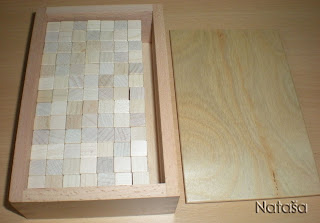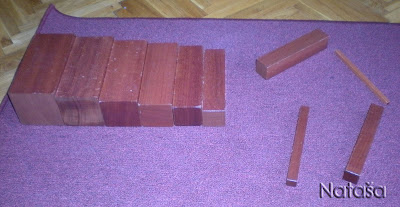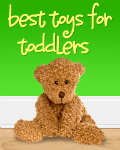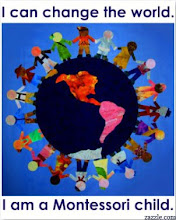Ružičasti toranj i smeđe stepenice. Djeca u mojoj grupi j a k o vole ovaj senzomotorički pribor koji služi za upoznavanje dimenzija. Zato ću malo detaljnije opisati osnovni način rada i dodatne vježbe koje radimo kad djeca nauče osnovni način izvođenja vježbe.
To su pribori koje pokazujem djeci čim se upišu u vrtić, jer ove vježbe mogu raditi djeca od 2,5 godine na dalje.
Pink tower and Brown stairs. The children in my Montessori classroom r e a l l y like this sensorial material used for exploring the dimensions. So, I'll describe in more detail the basic mode of work and extensions (we are doing extensions when children learn the basic mode).
You can show children these materials as they enroll kindergarten, because these exercises children can work from 2,5 years onward (in Croatia, children move from nursery to kindergarten when they turn three).
RUŽIČASTI TORANJ / PINK TOWER
Pribor se sastoji od deset ružičastih kocaka. (najmanja bi trebala biti velika 1 kubični cm, a najveća 10 kubičnih cm). Neposredni cilj ove vježbe je upoznavanje apstraktnih pojmova veliko i malo rukujući s konkretnim priborom (kockama). Djeca također obogaćuju rječnik uz komparaciju pridjeva - npr. mala, manja, najmanja kocka.
Material consist of ten pink cubes (the smallest cube should be 1 cubic cm, the biggest cube should be 10 cubic cm). One of the goals of this exercise is to introduce abstract concepts of big and small operating with a concrete material (cubes). Children also enrich their vocabulary with the comparison of adjectives - for eg. small, smaller, the smallest cube.
Nošenje kocaka djeci pokazujem kao na slikama (prva slika pokazuje kako se nose male kocke, a druga pokazuje kako se nose velike kocke - to je relativno, ovisi o veličini dječjeg dlana):
We are carrying cubes as shown on the photos (1st photo shows how to carry small cubes, and the 2nd shows how to carry big cubes - small and big is relative, it depends on the size of the childs palm):
Kocke na tepihu ne slažemo odmah, nego ih stavljamo bez reda (izgledaju razbacano); dijete nosi jednu po jednu kocku - time zadovoljava i potrebu za kretanjem:
We put cubes on the carpet with no order (look scattered), child is carrying cubes one by one - thus satisfies the need to move.
Kad su sve kocke na tepihu, dijete počinje slagati toranj uspoređujuči veličine kocaka:
When all the cubes are on the carpet, the child begins comparing the size of the cubes:
Toranj se slaže počevši od najveće kocke - najmanja je na vrhu tornja:
We put cubes in tower ranging from the largest cube - the smallest is on the top of the tower:
Kad je toranj složen, potičem djecu da ga obiđu i pogledaju sa svih strana. Toranj izgleda drugačije kad se gleda iz ptičje perspektive.
When the tower is complete, I encourage children to walk around the tower and look at it from all sides. The tower looks different when viewed from a bird's perspective.
Toranj se može slagati i na ovaj način (bridovi svih kocaka se s jedne strane podudaraju):
You can put the cubes that way too (all the edges of cubes match on one side):
Kada slažemo na taj način, dijete s najmanjom kockom provjerava da li je napravilo vježbu točno (najmanja kocka veličinom treba odgovarati prostoru između kocaka):
When we arrange it this way, the child checks with the smallest cube if she made the exercise correctly (the smallest cube size should correspond to the space between blocks):
Kad je dijete obišlo toranj i pogledalo kako izgleda sa svih strana, kocke opet stavlja na pod, bez reda. Ako ne želi ponoviti, pribor posprema na mjesto.
When the child walked around the tower and looked at how it looks from all the sides, she place cubes on the floor (carpet) again - without order. If she don't want to repeat the exercise, she put material (cubes) back in its place.
Kad je usvojilo osnovni način rada (opisan iznad), vježbu možemo nadograditi:
When the child learned the basic mode (described above), you can upgrade exercise:
- slaganje tornja horizontalno, npr: / stacking tower horizontally, for example:

- ocrtavanje kocaka na papiru, bojanje i izrezivanje / sketching cubes on paper, painting, cutting
- slaganje na dva udaljena tepiha (npr. na jednom tepihu je 5 kocaka i na drugom tepihu je pet kocaka - dijete treba složiti toranj uspoređujući kocke na udaljenim tepisima) / working on two distant carpets (on the first carpet is 5 cubes, on the second carpet is 5 cubes - the child should make a tower by comparing the tower cubes on two carperts)
- slaganje tornja s povezom na očima / working blindfolded
- slaganje tornja s povezom na očima na udaljenim tepisima (odgajatelj ili veliko dijete vodi dijete s povezom na očima do drugog tepiha) / working blindfolded on two distant carpets (teacher or an older child takes blindfolded child to another carpet)
- traženje sličnih predmeta u sobi / search for similar items in the room
- uspoređivanje s blokom C - valjci za umetanje (ružičasti toranj se složi horizontalno, pored svake kocke se stavi po jedan valjak iz bloka C) - vidi posljednju sliku u ovom postu / comparison with a block C - the cylinder blocks (you should put pink tower horizontally, and next to each cube is placed one cylinder from block C) - see the last picture in this post
- slaganje pojedinih kocaka od malih kocaka (koje veličinom odgovaraju najmanjoj kocki iz ružičastog tornja, Nienhuis ima ovaj pribor): / making individual pink tower cubes with small cubes (those corresponding to the smallest cubes of pink tower, Nienhuis have this material):


SMEĐE STEPENICE / BROWN STAIRS
Pribor se sastoji od deset kvadara koji se razlikuju u dvije dimenzije - visini i širini. Širina i visina najtanjeg kvadra bi trebale biti 1 cm, a najdebljeg 10 cm. Neposredni cilj ove vježbe je upoznavanje s apstraktnim pojmovima debelo i tanko. Dijete također obogaćuje rječnik komparirajući pridjeve - npr. tanko, tanje, najtanje.
Material consist of ten quadrant that differ in two dimensions - height and width. The width and height of the thinnest quadrant should be 1 cm, and the thickest 10 cm. One of the goals of this exercise is to introduce the abstract concepts of thick and thin. The child also enriches vocabulary comparing adjectives - for example: thin, thinner, the thinnest.
Nošenje kvadara djeci pokazujem kao na slikama (prva slika pokazuje kako se nose tanki kvadri, a druga pokazuje kako se nose debeli kvadri):
We are carrying quadrants as shown on the photos (1st photo shows how to carry thin quadrants, and the 2nd shows how to carry thick quadrants):


Debeli kvadri se, također, mogu nositi kao velike kocke ružičastog tornja (jedna ruka gore, druga dolje) što je, po mojem mišljenju, pravilnije - ako uzmemo u obzir da dijete radeći s ovim priborom uči pojmove debelo i tanko. Međutim, prošle pedagoške godine su kvadri djeci ispadali iz ruku ako su ih na taj način nosili (teški i debeli kvadri nestabilno stoje u malim dječjim rukama). Na sreću nitko nije ozlijedio nogu, ali sam zato odlučila da je za djecu sigurnije da kvadre nose kao na gornjoj slici.
Thick quadrants can be also carried as a big pink tower cubes (one hand on the upper side, the second from the bottom) which is correctly, in my opinion - considering that the child working with this material learns the concepts thick and thin. However, the last year quadrants were fell from the hands if they were worn like that (heavy and thick quadrants are unstable in little children's hands). Fortunately nobody was injured, but because of that I decided it was safer for children to carry quadrants as shown on the photo above.
Kad je donijelo sve kvadre na tepih, dijete može početi slagati smeđe stepenice. Počinje se od najdebljeg kvadra.
When she brought all the quadrants on the carpet, the child can begin to arrange brown stairs. Start from the thickest square.
Debljina kvadara se za vrijeme slaganja uspoređuje, kao i veličina kocaka za vrijeme slaganja ružičastog tornja.
Thickness of quadrants is compared during the exercise, as well as the size of cubes during the pink towerexercise.
Kad su smeđe stepenice složene, potičem djecu da ustanu, obiđu tepih, i pogledaju ih sa svih strana.
When the brown stairs are complete, I encourage children to walk around the stairs and look at it from all sides.
Djeca vole pustiti lopticu niz smeđe stepenice (ako je pribor točno složen, loptica će se otkotrljati po stepenicama, ako nije, upast će između dvije stepenice):
Children love to let the little ball downstairs (if the quadrants are arranged precisely, the ball will roll downstairs, if not, will fall between two steps):
Ispravnost rada se provjerava tako da najtanjim kvadrom klizimo po stepenicama - njegova visina mora odgovarati razlici između dvije stepenice.
Accuracy of work is checked by the thinnest quadrant - we slide it over the stairs - its height must match the difference between the two steps.
Kad je završilo vježbu, dijete vraća smeđe stepenice na mjesto (ili radi ponovo, ako želi).
When the exercise is finished, the child returns the brown stairs to its place (or work again, if she want).
Kad je usvojilo osnovni način rada (opisan iznad), vježbu možemo nadograditi:
When the child learned the basic mode (described above), you can upgrade exercise:
- ocrtavanje stepenica na papiru, bojanje i izrezivanje / sketching quadrants on paper, painting, cutting
- slaganje smeđih stepenica s povezom na očima / working blindfolded
- slaganje stepenica s povezom na očima na udaljenim tepisima (odgajatelj ili veliko dijete vodi dijete s povezom na očima do drugog tepiha) / working blindfolded on two distant carpets (teacher or an older child takes blindfolded child to another carpet)
- slaganje smeđih stepenica vertikalno: / stacking brown stairs vertically:


- slaganje smeđih stepenica u visinu (jednu na drugu) - vrlo opasno, obavezno uz nadzor odrasle osobe / brown stairs in height (one stair to another) - very dangerous, always with adult supervision; (najtanju stepenicu još nikad nismo uspjeli staviti na vrh - uvijek padne / thinnest step has never managed to put on top - always falls)

- traženje predmeta istog oblika u sobi / search items of the same shape in the room
- slaganje pojedinih stepenica od tankih kvadara (koji odgovaraju najtanjem kvadru iz ovog pribora, može se nabaviti kod Nienhuisa) / stacking individual steps of the thin quadrant (corresponding to the thinnest quadrant of brown stairs, can be purchased at Nienhuis)


U dodatne vježbe za ružičasti toranj i smeđe stepenice ubrojila bih i kombinacije ova dva pribora. Neke kombinacije su smislila djeca iz grupe, neke kombinacije sam smislila ja, ali moram spomenuti i zanimljiv blog
Our Montessori Story. Tu sam pronašla zgodne
kombinacije ružičastog tornja i smeđih stepenica (ako kliknete na link možete besplatno downloadati) koje sam isprintala i plastificirala. Moram priznati da djeca jako vole slagati kombinacije gledajući u ove kartice. Najčešće rade u paru.
The additional exercises for the pink tower and brown stairs are also combinations of these two materials. Some combinations are devised from the children in my class, some combinations I made up by myself, but I must mention an interesting blog Our Montessori Story. I found there a nice combinations of pink tower and brown stairs (if you click on the link you can download cards for free) and I printed and laminated it. I must admit that the children really love to make a combinations looking at those cards. Children most often work in pairs. 





Zgodna je i usporedba dimenzija smeđih stepenica, ružičastog tornja i valjaka za umetanje iz bloka C:
Comparison of dimensions of brown stairs, pink tower and cylinders from block C:
Ako netko zna kako još napraviti dodatnu vježbu za ružičasti toranj i/ili smeđe stepenice, bila bih sretna da stavi link ili opiše svoju ideju.
If anyone knows how to make more additional exercises for pink tower and / or brown stairs, I would be happy if you put a link or describe your idea.















































































































